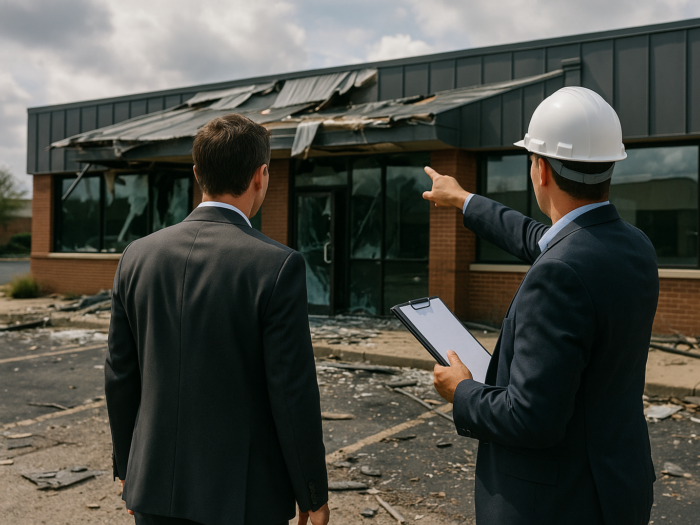Weather Risk Concerns Surge Among Commercial Property Stakeholders

Commercial property stakeholders are increasingly worried about severe weather events, with concern jumping significantly since 2023, especially in states prone to wildfires and hurricanes, according to a recent Nationwide survey.
This heightened concern comes as property damage from natural disasters affects roughly one-third of property owners nationwide, and more than half in high-risk regions, Nationwide found.
“Our research shows one-third of property owners have faced natural disaster damage in the past five years, and that number jumps significantly to over half in wildfire-prone states and nearly two-thirds in hurricane-prone states,” said Mark McGhiey, leader of Risk Management and Client Services at Nationwide. “This data highlights the urgent need for property stakeholders to not only be aware of these risks, but to take proactive steps in mitigating them.”
The 2025 Commercial Lines Protection Survey surveyed commercial property stakeholders — property owners, business owners and construction firms — as well as independent agents that sell commercial property coverage.
Severe Weather Risk Perception
Nationwide found that 73% of commercial property stakeholders ranked severe weather as a top concern, approaching the 76% who cited government regulation/zoning change worries as their top risk. Severe weather concerns were even higher in wildfire-prone states (94%) and hurricane-risk states (88%), where it ranked ahead of government regulations.
Specific weather threats have seen notable increases in perceived risk since 2023, Nationwide found. Damaging winds topped the 2025 list of perceived weather risks for commercial property at 88% nationally, up 18 points from a 2023 survey. Flood and lightning were both cited by 78%, up 12 and 13 points respectively.
Of note, perceived wildfire risk was only 24% nationally, down 24 points. But in wildfire-prone states, wildfire was the top perceived risk at 95%, followed by damaging winds (86%) and severe heat wave (77%). In hurricane-risk states, the top perceived risk was tropical storm/hurricane (96%), followed by damaging winds (90%) and tornado (88%).
Asked to identify the top risks to property and businesses from severe weather, respondents nationally cited structural damage (50%), business interruption (41%) and roof damage (38%), as their top three. In wildfire-risk states, the top three business risks shifted to smoke/fire damage (69%), structural damage (56%) and damaged electrical systems (37%). For hurricane-risk states, the top three business risks were roof damage (47%), structural damage (45%) and water intrusion/flood damage (40%).
Severe Weather Losses Incurred
Nationally, 32% of commercial property stakeholders reported they have incurred damage from severe weather in the past five years. That percentage rises to 54% in wildfire-risk states and 63% in hurricane-risk states, the survey found.
Among property owners that had property damage, the top five types of damage were:
- Broken windows, 43% and unchanged from 2023.
- Structural damage, 41%, down 11 points.
- Damaged electrical systems, 39%, unchanged.
- Roof damage, 37% down 12 points.
- Business interruption, 37%, down 13 points.
The financial and operational impact of these events has been substantial. While most affected property owners (71%) reported recovery costs under $10,000, nearly a quarter (23%) faced expenses between $10,000-$50,000, and 8% had more than $20,000 in costs.
Among those with property damage, 46% said all damage was covered by insurance, Nationwide found.
Mitigation Strategies and Solutions
While 95% of national property stakeholders said they have a response plan in place in the event of severe weather damage, 1 in 5 agents (19%) estimate that less than half of their clients have a risk management plan in place to prevent weather disruptions, Nationwide reported.
In addition, commercial property stakeholders are doing less to proactively mitigate risks, suggesting economic uncertainty and increased construction costs are barriers to taking action, according to the report. Only 31% of national stakeholders report willingness to invest in measures that improve their properties’ resilience to weather events, a 22-point drop from 2023.
Despite these challenges, the survey tracked the actions commercial property stakeholders willing to invest are taking to protect their properties. The top mitigation actions taken nationally are installed weather-resistant doors and windows, 73%, installed backup power systems, 60% and installed storm shutters or reinforced windows for hurricanes/tornadoes, 57%.
In wildfire risk states, the top efforts were landscaped or modified property to manage wildfire risk, 85%, developed or updated an emergency preparedness plan, 71%, and installed weather-resistant doors and windows, 44%.
In hurricane-risk states, the top actions were installed storm shutters or reinforced windows for hurricanes/tornadoes, 78%, installed weather-resistant doors and windows, 72%, and developed or updated an emergency preparedness plan, 71%.
Obtain the full report here. &










